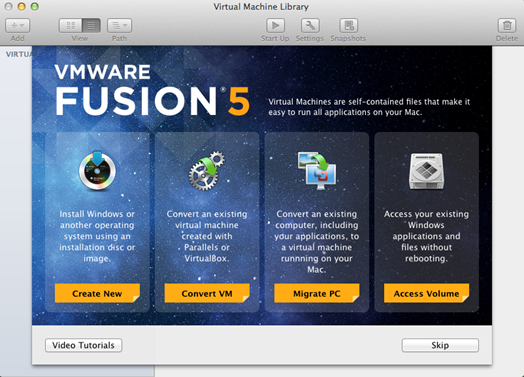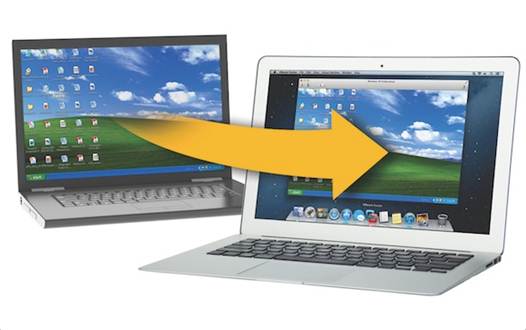VMware and Parallels generally update their
virtualization offerings in sync, both making it more seamless to run Windows
on a Mac. So it was no surprise to see Fusion 5 ship just ahead of Parallels 8.
It's optimized for Mountain Lion and Windows 8, supports USB 3 and Retina
display, has enhanced battery management and, says VMware, is faster.

Quick
off the mask Fusion's setup routine takes all of the pain out of installing
Windows, and even lets you access existing Boot Camp partitions
|
It groups multiple Instances of a single
Windows application in the same way that it would group each of the windows
of an OS X app
|
We tested it on modestly capable Mac-Book
Pro Mid 2010 running Mountain Lion on a 2.4GHz Intel Core 2 Duo processor with
4GB of RAM. Installing the 64-bit version of Windows 8 was easy and took 28
minutes, including setting up a Windows account. You can opt for
the express method, which chooses the most common settings and activates the
OS, or step through the custom installation, as we did. Fusion allocated the
virtual machine one processor core and 1GB of memory.
If you've already installed Windows on your
Mac under Boot Camp, you can access that using Fusion to save switching out of
OS X entirely, or convert a Parallels or Virtual Box machine to Fusion format.
Booting Windows 8 for the second time,
after the system had been optimized, took 47 seconds. Resuming a suspended
machine took just 35 seconds.
Mountain Lion's multi-finger scrolling transfers
smoothly to Windows apps, and tile-based apps running what was previously known
as the Metro interface ran well as fullscreen applications in OS X. The Windows
8 Charms, which form part of the Edge UI and slide in as you move the mouse to
the right-hand side of the screen, work fine when you've given over the whole
screen to Windows or you're running it in a single window, but don't work in
Unity mode (which lets you run individual Windows apps as though they were OS X
natives). Neither did a double-press of the Fn key extend Mountain Lion's
dictation features into our Windows applications.
Fusion accurately renders thevirtual
machine on its own desktop in Mission Control if you're running it full screen
and does the same with Metro-style applications –but you can't give over the
whole screen to a regular standalone Windows 7-style application. It does,
however, correctly group multiple instances of a single Windows application in
the same way that it would group each of the windows of an OSX app for easy
navigation.
VMware throws in 18 months of complimentary
email support, and for new users there's also a year's subscription to McAfee
Anti-Virus Plus, although if you're upgrading from Fusion 4 and signed up for
virus protection with your last installation more than a year ago, you'll have
to pay to maintain that protection or look for an alternative such as the free
Microsoft Security Essentials.

VMware
Fusion 5 is recommended for home users who are looking for the easiest, fastest
and most reliable way to run Windows programs on a Mac
Fusion 5 ships in standard and professional
editions, the latter adding support for restricted virtual machine containers
that limit what end users can do and allow system admins to disable features
such as connecting USB devices to Windows. 'Professional' virtual machines can
be encrypted and deployed en masse in a standard configuration, and have access
to support and VMware Player. Fusion 5 primarily delivers increased speed and
improved battery life, with VMware claiming an extra 100 minutes of working
time over Fusion 4. Whichever virtualisation platform you choose, you want it
to be as unobtrusive as possible while you concentrate on the software running
within. Fusion has always done well in this respect, and with better Mountain
Lion integration, good behavior in Mission Control and integration with
Notification Center, we have no complaints here.
Up to 8GB of RAM can be allocated to each
virtual machine, and the overall memory headroom has been raised to 60GB. However,
the greatest benefits will be reaped by those who've bought a new Mac since
Fusion 4 hit the shelves. If you're in that camp, the $61.31 upgrade fee looks
like a good investment - despite representing less than a $4.86 discount on the
standalone price. If not, it's harder to justify; but new users won't be
disappointed.
|
Information
Price: $64.91 for Standard edition - Professional edition $106.71
From: vmware.com
Needs
·
64-bit Intel processor
·
2GB RAM (4GB or more recommended)
·
750MB free disk space for VMware Fusion and at
least 5GB for each virtual machine
·
OS X 10.6.7 or later
·
OS installation media (disk or disk image) for
virtual machines
Pro
·
Inexpensive
·
Good OS X integration
·
Can run Boot Camp installations directly
Con
·
Some small gaps in integration
·
Many improvements specifically address only
the newest Macs
|